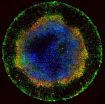(Press-News.org) In a new study of the causes underlying respiratory symptoms in military personnel returning from duty in Iraq and Afghanistan, a large percentage of veterans had non-specific symptoms that did not lead to a specific clinical diagnosis. Most patients who did receive a diagnosis had evidence of asthma or nonspecific airway hyperreactivity, which may have been due in some cases to aggravation of pre-existing disease by deployment exposures.
"Earlier studies of military personnel deployed in Southwest Asia have shown increases in non-specific respiratory symptoms related to exposure to increased levels of airborne particulate matter," said lead author Michael J. Morris, MD, of the San Antonio Military Medical Center in Texas. "Accordingly, we conducted a prospective study of 50 consecutive individuals returning from active duty in Iraq and/or Afghanistan with new onset pulmonary symptoms to assess possible causes."
The study was published in the July 1 issue of the American Thoracic Society's American Journal of Respiratory and Critical Care Medicine.
All study subjects completed a questionnaire detailing deployment history, airborne exposures, smoking history, pulmonary symptoms and medical treatment and underwent baseline spirometry, high resolution chest tomography, methacholine challenge testing and fiberoptic bronchoscopy with bronchoalveolar lavage.
Testing did not result in a specific diagnosis in 42% of the patients, including 12% of the patients who had normal testing but an isolated increase in neutrophils or lymphocytes (white blood cells that are increased in asthma). Evidence of airway hyperreactivity was seen in 36% of the sample, including 16% who met criteria for asthma and 20% with nonspecific airway hyperreactivity. Two patients had findings suggestive of airway hyperreactivity secondary to gastroesophageal reflux.
None of the patients had imaging results indicating the need for lung biopsy. Underlying mental health and sleep disorders were present in 66% of the patients.
"Evaluation of military personnel returning from duty in Southwest Asia with new onset respiratory symptoms should focus on airway hyperreactivity, although identifying an underlying cause and establishing a diagnosis may be difficult, and additional testing and follow-up may be necessary," said Dr. Morris. "Pre-existing underlying disease may play a role in respiratory symptoms in some patients, and mental health and sleep disorders, which were common in our sample, may also play a role in the occurrence of these symptoms."
INFORMATION:
About the American Journal of Respiratory and Critical Care Medicine:
With an impact factor of 11.041, the AJRRCM is a peer-reviewed journal published by the American Thoracic Society. It aims to publish the most innovative science and the highest quality reviews, practice guidelines and statements in the pulmonary, critical care and sleep-related fields.
Founded in 1905, the American Thoracic Society is the world's leading medical association dedicated to advancing pulmonary, critical care and sleep medicine. The Society's 15,000 members prevent and fight respiratory disease around the globe through research, education, patient care and advocacy.
Deployment-related respiratory symptoms in returning veterans
2014-07-01
ELSE PRESS RELEASES FROM THIS DATE:
Foodborne bacteria can cause disease in some breeds of chickens after all
2014-07-01
Contrary to popular belief, the foodborne pathogen Campylobacter jejuni is not a harmless commensal in chickens but can cause disease in some breeds of poultry according to research published in mBio®, the online open-access journal of the American Society for Microbiology.
"The main implication is that Campylobacter is not always harmless to chickens. This rather changes our view of the biology of this nasty little bug," says Paul Wigley of Institute for Infection and Global Health at the University of Liverpool, an author on the study.
Campylobacter jejuni is the ...
The inhibition of a protein opens the door to the treatment of pancreatic cancer
2014-07-01
Researchers from IMIM (Hospital del Mar Medical Research Institute) have identified a new protein, galectin-1, as a possible therapeutic target for pancreatic cancer. For the first time they have demonstrated the effects of the inhibition of this protein in mice suffering this type of cancer and the results showed an increase in survival of 20%. The work further suggests that it could be a therapeutic target with no adverse effects.
Until now, the strategies for treating this tumour were aimed at attacking the tumour cells and had little success. The latest studies indicate ...
Scientists chart a baby boom -- in southwestern Native-Americans from 500 to 1300 A.D.
2014-06-30
Scientists have sketched out one of the greatest baby booms in North American history, a centuries-long "growth blip" among southwestern Native Americans between 500 and 1300 A.D.
It was a time when the early features of civilization--including farming and food storage--had matured to a level where birth rates likely "exceeded the highest in the world today," the researchers report in this week's issue of the journal Proceedings of the National Academy of Sciences.
Then a crash followed, says Tim Kohler, an anthropologist at Washington State University (WSU), offering ...
Lead in kids' blood linked with behavioral and emotional problems
2014-06-30
Emotional and behavioral problems show up even with low exposure to lead, and as blood lead levels increase in children, so do the problems, according to research funded by the National Institute of Environmental Health Sciences (NIEHS), part of the National Institutes of Health. The results were published online June 30 in the journal JAMA Pediatrics.
"This research focused on lower blood lead levels than most other studies and adds more evidence that there is no safe lead level," explained NIEHS Health Scientist Administrator Kimberly Gray, Ph.D. "It is important to ...
Malaria parasite manipulates host's scent
2014-06-30
UNIVERSITY PARK, Pa. -- Malaria parasites alter the chemical odor signal of their hosts to attract mosquitos and better spread their offspring, according to researchers, who believe this scent change could be used as a diagnostic tool.
"Malaria-infected mice are more attractive to mosquitos than uninfected mice," said Mark Mescher, associate professor of entomology, Penn State. "They are the most attractive to these mosquito vectors when the disease is most transmissible."
Malaria in humans and animals is caused by parasites and can be spread only by an insect vector, ...
Adults can undo heart disease risk
2014-06-30
CHICAGO --- The heart is more forgiving than you may think -- especially to adults who try to take charge of their health, a new Northwestern Medicine® study has found.
When adults in their 30s and 40s decide to drop unhealthy habits that are harmful to their heart and embrace healthy lifestyle changes, they can control and potentially even reverse the natural progression of coronary artery disease, scientists found.
The study was published June 30 in the journal Circulation.
"It's not too late," said Bonnie Spring lead investigator of the study and a professor of ...
New Tel Aviv University research links Alzheimer's to brain hyperactivity
2014-06-30
Patients with Alzheimer's disease run a high risk of seizures. While the amyloid-beta protein involved in the development and progression of Alzheimer's seems the most likely cause for this neuronal hyperactivity, how and why this elevated activity takes place hasn't yet been explained – until now.
A new study by Tel Aviv University researchers, published in Cell Reports, pinpoints the precise molecular mechanism that may trigger an enhancement of neuronal activity in Alzheimer's patients, which subsequently damages memory and learning functions. The research team, led ...
Study helps unlock mystery of high-temp superconductors
2014-06-30
A Binghamton University physicist and his colleagues say they have unlocked one key mystery surrounding high-temperature superconductivity. Their research, published this week in the Proceedings of the National Academy of Sciences, found a remarkable phenomenon in copper-oxide (cuprate) high-temperature superconductors.
Michael Lawler, assistant professor of physics at Binghamton, is part of an international team of physicists with an ongoing interest in the mysterious pseudogap phase, the phase situated between insulating and superconducting phases in the cuprate phase ...
Tropical countries' growing wealth may aid conservation
2014-06-30
DURHAM, N.C. -- While inadequate funding has hampered international efforts to conserve biodiversity in tropical forests, a new Duke University-led study finds that people in a growing number of tropical countries may be willing to shoulder more of the costs on their own.
"In wealthier developing countries, there has been a significant increase in public demand for conservation, which has not yet been matched by an equivalent increase in protective actions by the governments of those countries," said Jeffrey R. Vincent, a Duke environmental economist who led the study, ...
Using geometry, researchers coax human embryonic stem cells to organize themselves
2014-06-30
About seven days after conception, something remarkable occurs in the clump of cells that will eventually become a new human being. They start to specialize. They take on characteristics that begin to hint at their ultimate fate as part of the skin, brain, muscle or any of the roughly 200 cell types that exist in people, and they start to form distinct layers.
Although scientists have studied this process in animals, and have tried to coax human embryonic stem cells into taking shape by flooding them with chemical signals, until now the process has not been successfully ...


